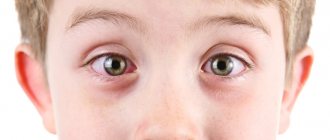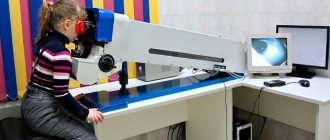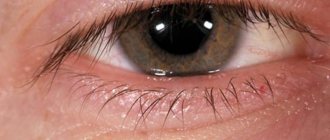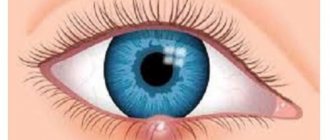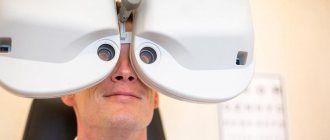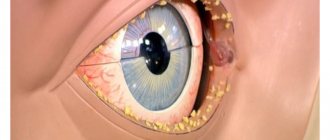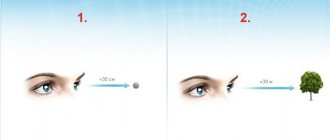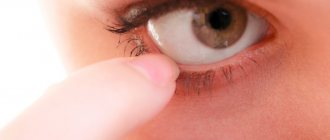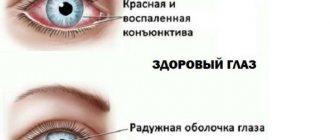What are the causes of blepharospasm
The exact pathophysiology underlying the development of blepharospasm is still unknown, but it is thought to be multifactorial, with a likely genetic component and environmental triggers.
It has been suggested that it is associated with abnormalities in the basal ganglia and dopaminergic system of the brain. Etiology:
- Parkinson's disease;
- Regular use of antipsychotic and other medications;
- Trichiasis;
- Supranuclear palsy;
- Entry of a foreign body;
- Dry eye syndrome;
- Neoplasms;
- Cortical epilepsy;
- Inflammation of the sinuses, teeth, nasopharynx;
- Blepharitis.
Provoking factors:
- Hypo- and vitamin deficiency;
- Long work at the computer;
- Stress;
- Sleep disorders;
- Physical and mental fatigue.
Benign essential blepharospasm is associated with a family history of dystonia, head or facial trauma, and other neurological movement disorders (eg, Tourette's syndrome).
Secondary pathology manifests against the background of focal lesions in several areas of the brain or develops in patients with tardive dyskinesia. Finally, secondary blepharospasm often occurs as a result of conditions associated with eyelid weakness, such as facial palsy and myasthenia gravis.
Diagnostics
Blepharospasm is accompanied by specific symptoms, which make it possible to easily identify the disease. However, an accurate diagnosis is required. If you suspect the development of pathology, immediately visit the clinic for a medical examination and choose a course of therapy.
Initially, the doctor analyzes the muscular system of the face; for this, electromyography of the facial muscles is performed. The procedure makes it possible to measure the speed of impulse transmission through the receptors of the blink reflex. If necessary, the patient is asked to undergo blood and urine tests.
When compiling an anamnesis, a number of criteria are taken into account:
- Degree of damage. The illness has damaged one or both sides;
- Which muscles are affected by the disease;
- A list of medications that the patient has used recently.
The patient must be checked for the presence of blepharitis and the possibility of the presence of a foreign object in the organ of vision.
To confirm the diagnosis and detect associated anomalies, a comprehensive diagnosis is performed, which includes the following procedures:
- MRI. Magnetic resonance therapy is performed to detect malignant or benign tumors in the brain;
- Rheoencephalography. Study of the vascular system and intensity of blood circulation in the brain;
- Electroencephalography. Allows you to analyze bioelectric impulses emanating from nerve cells. It is carried out to assess the level of brain functionality;
- Biomicroscopy. Detailed study of the internal structures of the eye;
- Ophthalmoscopy. It is carried out to analyze the condition of the retina and fundus of the eye;
- Visometry. Visual acuity study.
For differential diagnosis, hemifacial spasm, myokymia, and Tourette's syndrome are used. Unlike blepharospasm, with hemifacial disease, spasms can occur during sleep. Myokymia is accompanied by twitching of the eyelids due to mechanical injuries to the organ of vision or as a result of stress. Most often, the anomaly affects only one eyelid. Tourette syndrome is characterized by frequent involuntary tics accompanied by the production of strange sounds or swear words.
Symptoms of blepharospasm
Symptoms are characterized by stereotypical, bilateral and synchronous spasms of the orbicularis oculi muscles. The spasms can be brief or long lasting and can cause the eyelids to narrow or close.
Focal dystonia, manifested by involuntary closure of the eyelid, has two stages:
- Tonic;
- Clonic.
The clonic form is characterized by frequent involuntary blinking. The problem usually begins on one side and then moves to the second organ.
| It should be noted that unilateral lesions practically never occur. |
Over time, the duration and intensity of the clonic spasm gradually increases. In this case, the patient closes his eyes tightly and for a long time against his will. In this case, the nosology moved to another stage - tonic. In severe cases of the disease, mechanical blindness develops in 70% of patients. A person loses visual function because he cannot open his eyelids. Young girls suffering from hysterical seizures experience bilateral squinting that lasts for several hours.
A distinctive feature of hysteria is that when pressing on the exit points of the branches of the trigeminal nerve, the spasmodic state of the periocular muscles is stopped.
Main manifestations:
- Intense twitching of the eyelids;
- Frequent blinking;
- Excessive tearing;
- Photophobia, burning and itching;
- Involuntary squinting;
- Areas of maceration on the skin of the eyelids;
- Impaired outflow of tear fluid.
Psychiatric changes include depression, anxiety, and obsessive-compulsive disorder. If the pathological process proceeds for a long time and is painful, then it becomes difficult for the individual to fulfill his professional duties, take care of himself at home, interpersonal interaction and emotional balance are disrupted.
| Sudden attacks interfere with driving and provoke emergency situations on the road. |
Blepharospasm and its forms
Blepharospasm is a neurological syndrome accompanied by a reflex, uncontrolled contraction of certain facial muscles. Frequent blinking and drooping of the eyelids occur. The resulting pain and pain can be so severe that it is easier for a person to be in the dark than to try to open his eyes. Against the background of such manifestations, photophobia develops.
Blepharospasm is a neurological syndrome accompanied by a reflex, uncontrolled contraction of certain facial muscles
Blepharospasm itself does not harm the patient’s physical health, but can cause emotional distress and depression. There are two forms of the disease:
- Primary. It manifests itself as bouts of blinking and periodic difficulty raising the eyelids. It occurs either in youth or at the age of about 40 years, when age-related “restructuring” of the visual apparatus occurs. It can appear unexpectedly and go away just as unexpectedly.
- Secondary. It is a consequence of the presence of certain pathologies in the body: cysts and brain tumors, disturbances in the functioning of the circulatory system, rupture and damage to blood vessels.
If the pathology is observed for more than two years, it enters the chronic stage. The following types of chronic blepharospasm are distinguished:
- Clonic. Expressed in rapid, involuntary blinking, similar to a tic. But it can also manifest itself as slow, difficult opening and closing of the eyes. May spread to the muscles of the mouth and cause dystonia of the facial muscles.
- Tonic. It is characterized by prolonged drooping of the eyelids, the duration varies from several hours to several weeks.
Treatment of blepharospasm
Treatment of the disease depends on its cause and predisposing factors.
If dry eye syndrome is detected, the doctor prescribes “artificial tears” in the form of drops with a moisturizing effect. If a foreign body enters the organ of vision, the ophthalmologist very carefully removes it and prescribes anti-inflammatory and absorbable medications. If, after a comprehensive examination, it is not possible to determine the exact etiology of the closure of the palpebral fissure, then several microdoses of botulinum toxin are injected into the periocular muscles. Botox causes paralysis of muscle fibers, and thus eliminates blepharospasm. Side effects such as transient ptosis, blurred vision or diplopia are relatively rare and usually disappear spontaneously after a few weeks.
Symptom resolution from botulinum toxin injections is considered temporary and requires repeated injections every three months for the remainder of the patient's life. Many affected individuals develop a more severe form and/or clinical resistance to botulinum toxin.
If the injections do not lead to positive and lasting results, the spasm still persists, then surgical intervention is indicated. During the operation, the surgeon completely or partially removes defective muscles in the area of the eyebrows and eyelids.
Electromyographic studies help determine the best injection sites for optimal response and differentiate patients who require limited or complete myectomy.
Treatment: folk remedies, acupuncture, neurology
The treatment methods available to the patient are divided into four categories:
- Treatment with folk remedies. It is necessary to understand that such serious diseases as a brain tumor cannot be eliminated with the help of alternative medicine. But some recipes can make the patient feel better and relieve or reduce attacks. Example: Valerian root juice should be dissolved in 100 ml of water and taken daily at night.
- Acupuncture. This type of treatment is included in the section of reflexology. Impact on key points of the facial area has a relaxing and calming effect, which helps reduce the symptoms of the disease.
- Traditional medicine. This category includes drugs that affect the patient's nerves. So, a specialist can prescribe anticonvulsants, sedatives, antipsychotics, and sometimes antidepressants and tranquilizers. But all these compounds have a number of side effects, so they can only be taken under the supervision of a physician.
- Direct effect on the muscle. Modern medicine has created two more effective ways to treat blepharospasm: the administration of Botox and surgery.
Injection today is one of the most effective and safe methods. The injected botoloxidine slightly paralyzes the muscle without causing significant harm to it. The result is noticeable in almost 100% of cases and lasts from 3 months to six months, after which the procedure is repeated.
The operation involves cutting the nerve or removing part of the muscle. But in this case, the procedure has some dangers, since the nerve recovers over time, and manipulation of the muscle requires the utmost care.
Traditional medicine
Instructions for using Betoptik eye drops can be found here. A drug to reduce intraocular pressure – Betoftan eye drops.
Prevention of blepharospasm
In modern medicine there are no specific ways to prevent blepharospasm. If the pathology has developed secondary, then it is necessary to avoid irritating factors as much as possible. Wear dark sunglasses in bright light. It is recommended to treat blepharitis and dry eyes with medication, eliminate stress if possible and reduce the dosage of the provoking drug. Ophthalmologists recommend excluding drinks that provoke stimulation of the central nervous system (coffee and strong tea). After working at the computer for a long time, it is better to do eye exercises.
If you notice that for some reason the frequency of blinking is increasing or you need to make an effort to close your eyelids, you should seek help from a neurologist or ophthalmologist.
At the Fedorov Clinic in Moscow, doctors will help diagnose the disease in a timely manner and prescribe treatment. Making an appointment Today: 17 registered
Causes of pathology
In many cases, it is not possible to determine the exact nature of the development of muscle twitching. Since the disease is of neurogenic origin, it is customary to identify several factors that can lead to the development of the disease:
- Eye pathologies of both inflammatory and traumatic nature. Problems such as blepharitis, dryness, or foreign body penetration into the cornea and conjunctiva lead to constant irritation. The excitability of the nerve that provides the functions of the organ increases, which causes disruption of its normal functioning. The entire area around the eye becomes susceptible to environmental factors. Reflex blinking, which is a protective mechanism, develops into symptoms of blepharospasm. A similar etiology can cause tics in a child.
- Medications can also cause the disorder. The use of antipsychotics can cause side effects such as spasms of the facial muscles. These drugs are widely used in neurology to correct mental disorders and other problems.
- Long-term exposure to adverse environmental factors. These include constant eye strain while working with text or at the computer, lack of proper rest, as well as general psycho-emotional stress. Blepharospasm of the eyes is a common problem in people suffering from insomnia and chronic fatigue syndrome.
- Poor nutrition can also negatively affect the health of the nervous system. The lack of a sufficient amount of vitamins and microelements in the menu provokes a disturbance in the transmission of impulses, which leads to the manifestation of muscle twitching.
Reviews
Patients often complain that treatment is ineffective or takes too long, completely forgetting about such important factors as proper nutrition and exercise.
- “The eye began to twitch after being fired and after a long job search. At first these were only isolated cases, but then things got worse. One day I woke up and just couldn't open it. I ran to the doctor, he prescribed all sorts of sedatives, asked about my rest and nutrition regimen, and found out that I hardly sleep or eat. He said that this creates additional stress on the nervous system, which is very bad. Following the doctor’s advice and taking everything prescribed, including herbal infusions, after a month of treatment I noticed significant improvements.”
- “The problems started after giving birth, I couldn’t cope on my own. The neurologist advised me to make masks and decoctions, prescribed antidepressants and recommended changing my daily routine.”
- “I’ve had problems with my eyes since childhood, but recently it’s gotten really bad. I save myself by washing it with herbal decoctions and applying lotions. The doctor recommended acupuncture, but I'm afraid"
Blepharospasm is an extremely unpleasant neurological disease. Sometimes it manifests itself, but most often it becomes a consequence of a complication after an illness. With blepharospasm, the eyelid first twitches, and then the eye stops opening. They are treated using natural and synthetic drugs; sometimes patients are prescribed surgery, failure to perform which can lead to loss of vision.
Watch a video about the disease:
Eye twitching - causes and treatment
A condition in which the orbicularis oculi muscle involuntarily contracts over a certain period of time is medically called a nervous tic, blepharospasm or hyperkinesis.
A similar phenomenon happens:
- primary (tic is rare and lasts no more than 10 minutes);
- secondary (eye twitching is repeated regularly, and can persist for several hours).
You can explain why the eye twitches by listing the most common causes of blepharospasm.
The violation often becomes a consequence (reasons for which the eye twitches):
- Excessive fatigue of the visual apparatus due to overstrain of the eye muscles.
- Significant stress on the nervous system.
- Ophthalmological diseases (conjunctivitis, keratitis, blepharitis and others).
- The use of lenses that causes drying of the mucous membrane.
- Prolonged use of medications that lead to irritation of the mucous membranes or negatively affect the brain.
- Rubbing your eyes with dirty hands or getting foreign bodies into them.
- A reaction to an allergen, accompanied by redness, itching, muscle twitching and swelling.
- Genetic factor. Typically, an involuntary contraction that is inherited goes away as you get older.
- Development of Gilles de la Tourette syndrome, Parkinson's disease, Bell's palsy and brain tumors.
- Vitamin deficiency. Due to a lack of calcium, glycine and magnesium, problems occur in the functioning of the nervous system. The situation is aggravated by excessive consumption of coffee, alcohol, black tea and energy drinks.
- Weakened immune forces after suffering from acute respiratory viral infections or acute respiratory infections.
- CNS disorders. The cause of nervous tics is increased reflex excitability and muscle hypertension.
- Problems with cerebral circulation and the development of arterial hypertension.
- Head bruises and birth injuries.
If a nervous tic appears regularly and causes significant discomfort, medical attention will be needed.
Twitching right eye - causes
Blepharospasm can affect any eye. However, there have long been signs that explain what events should be expected if twitching is noted in the right eye.
In this case, the phenomenon indicates profit and good news. And young girls should prepare to meet their future spouse.
If the tick affects the left eye
If there was discomfort on the left side, people tried to recover from it as quickly as possible, since the sign indicated impending losses and troubles.
Regardless of the meaning of beliefs, you should not rely on them. The presence of hyperkinesis is a signal that a person should consult a doctor.
How to get rid of the problem, treatment for adults
What is the treatment if the eye twitches? The easiest way to cope with a nervous tic is at the initial stage, and you need to act comprehensively.
When the eye twitches in adults (manifestations of blepharospasm are noted), treatment requires compliance with a list of recommendations:
- Regular exercises aimed at relaxing the eye muscles are recommended.
- If the cause of hyperkinesis is a stressful condition, herbal infusions with a sedative effect or drugs (tablets, drops) that help eliminate neuroses are prescribed.
- It is necessary to adjust the daily routine and review the nutritional diet.
- When a spasm begins to bother you, doctors advise giving your eyes a little rest by blinking frequently.
- In the presence of primary blepharospasm, it is worth minimizing communication with people who contribute to the deterioration of the emotional state.
- It would not hurt to take vitamins, the deficiency of which provoked a nervous tic.
- Often the disorder is caused by excessive dryness of the mucous membrane, so drops with a moisturizing property may be needed.
If the problem is the result of a disease, the patient will need to undergo a full course of therapy using appropriate medications.
Is it possible to cure blepharospasm using traditional methods?
It is impossible to get rid of blepharospasm forever without surgery (removing the damaged part of the muscle and cutting the nerves). Over time, the disease returns and manifests itself with renewed vigor. To prevent this from happening, treatment should not be interrupted for a minute, even after all negative signs have disappeared. Traditional methods of treatment are ideal in this regard.
But blepharospasm cannot be treated exclusively with folk remedies; it is more of an auxiliary than a primary therapy. The choice of treatment method must be entrusted to the doctor.
